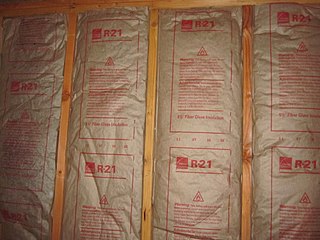Mathematical formulation of Newton's law
The statement of Newton's law used in the heat transfer literature puts into mathematics the idea that the rate of heat loss of a body is proportional to the difference in temperatures between the body and its surroundings. For a temperature-independent heat transfer coefficient, the statement is:
where
- is the heat flux transferred out of the body (SI unit: watt/m2),
- is the heat transfer coefficient (assumed independent of T and averaged over the surface) (SI unit: W/m2⋅K),
- is the temperature of the object's surface (SI unit: K),
- is the temperature of the environment; i.e., the temperature suitably far from the surface (SI unit: K),
- is the time-dependent temperature difference between environment and object (SI unit: K).
In global parameters by integrating on the surface area the heat flux, it can be also stated as:
where
- is the rate of heat transfer out of the body (SI unit: watt),
- is the heat transfer coefficient (assumed independent of T and averaged over the surface) (SI unit: W/m2⋅K),
- is the heat transfer surface area (SI unit: m2),
- is the temperature of the object's surface (SI unit: K),
- is the temperature of the environment; i.e., the temperature suitably far from the surface (SI unit: K),
- is the time-dependent temperature difference between environment and object (SI unit: K).
If the heat transfer coefficient and the temperature difference are uniform along the heat transfer surface, the above formula simplifies to:
.
The heat transfer coefficient h depends upon physical properties of the fluid and the physical situation in which convection occurs. Therefore, a single usable heat transfer coefficient (one that does not vary significantly across the temperature-difference ranges covered during cooling and heating) must be derived or found experimentally for every system that is to be analyzed.
Formulas and correlations are available in many references to calculate heat transfer coefficients for typical configurations and fluids. For laminar flows, the heat transfer coefficient is usually smaller than in turbulent flows because turbulent flows have strong mixing within the boundary layer on the heat transfer surface. [6] Note the heat transfer coefficient changes in a system when a transition from laminar to turbulent flow occurs.
The Biot number
The Biot number, a dimensionless quantity, is defined for a body as
where
- h = film coefficient or heat transfer coefficient or convective heat transfer coefficient,
- LC = characteristic length, which is commonly defined as the volume of the body divided by the surface area of the body, such that ,
- kb = thermal conductivity of the body.
The physical significance of Biot number can be understood by imagining the heat flow from a hot metal sphere suddenly immersed in a pool to the surrounding fluid. The heat flow experiences two resistances: the first outside the surface of the sphere, and the second within the solid metal (which is influenced by both the size and composition of the sphere). The ratio of these resistances is the dimensionless Biot number.
If the thermal resistance at the fluid/sphere interface exceeds that thermal resistance offered by the interior of the metal sphere, the Biot number will be less than one. For systems where it is much less than one, the interior of the sphere may be presumed always to have the same temperature, although this temperature may be changing, as heat passes into the sphere from the surface. The equation to describe this change in (relatively uniform) temperature inside the object, is the simple exponential one described in Newton's law of cooling expressed in terms of temperature difference (see below).
In contrast, the metal sphere may be large, causing the characteristic length to increase to the point that the Biot number is larger than one. In this case, temperature gradients within the sphere become important, even though the sphere material is a good conductor. Equivalently, if the sphere is made of a thermally insulating (poorly conductive) material, such as wood or styrofoam, the interior resistance to heat flow will exceed that at the fluid/sphere boundary, even with a much smaller sphere. In this case, again, the Biot number will be greater than one.
Values of the Biot number smaller than 0.1 imply that the heat conduction inside the body is much faster than the heat convection away from its surface, and temperature gradients are negligible inside of it. This can indicate the applicability (or inapplicability) of certain methods of solving transient heat transfer problems. For example, a Biot number less than 0.1 typically indicates less than 5% error will be present when assuming a lumped-capacitance model of transient heat transfer (also called lumped system analysis). [7] Typically, this type of analysis leads to simple exponential heating or cooling behavior ("Newtonian" cooling or heating) since the internal energy of the body is directly proportional to its temperature, which in turn determines the rate of heat transfer into or out of it. This leads to a simple first-order differential equation which describes heat transfer in these systems.
Having a Biot number smaller than 0.1 labels a substance as "thermally thin," and temperature can be assumed to be constant throughout the material's volume. The opposite is also true: A Biot number greater than 0.1 (a "thermally thick" substance) indicates that one cannot make this assumption, and more complicated heat transfer equations for "transient heat conduction" will be required to describe the time-varying and non-spatially-uniform temperature field within the material body. Analytic methods for handling these problems, which may exist for simple geometric shapes and uniform material thermal conductivity, are described in the article on the heat equation.





































